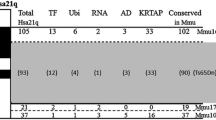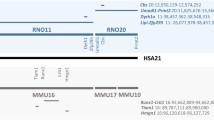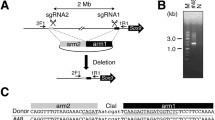Abstract
Down syndrome (DS), also known as Trisomy 21, is the most common chromosome aneuploidy in live-born children and displays a complicated symptom. To date, several kinds of mouse models have been generated to understand the molecular pathology of DS, yet the gene dosage effects and gene(s)-phenotype(s) correlation are not well understood. In this study, we established a novel method to generate a partial trisomy mice using the mouse ES cells that harbor a single copy of human artificial chromosome (HAC), into which a small human DNA segment containing human chromosome 21 genes cloned in a bacterial artificial chromosome (BAC) was recombined. The produced mice were found to maintain the HAC carrying human genes as a mini-chromosome, hence termed as a Trans-Mini-Chromosomal (TMC) mouse, and HAC was transmitted for more than twenty generations independent from endogenous mouse chromosomes. The three human transgenes including cystathionine β-synthase, U2 auxiliary factor and crystalline alpha A were expressed in several mouse tissues with various expression levels relative to mouse endogenous genes. The novel system is applicable to any of human and/or mouse BAC clones. Thus, the TMC mouse carrying a HAC with a limited number of genes would provide a novel tool for studying gene dosage effects involved in the DS molecular pathogenesis and the gene(s)-phenotype(s) correlation.




Similar content being viewed by others
Abbreviations
- DS:
-
Down syndrome
- HAC:
-
Human artificial chromosome
- BAC:
-
Bacterial artificial chromosome
- TMC mouse:
-
Trans-mini-chromosomal mouse
- CBS:
-
Cystathionine β-synthase
- U2AF1:
-
U2 auxiliary factor
- CRYAA:
-
Crystalline alpha A
- FISH:
-
Fluorescence in situ hybridization
- ES cell:
-
Embryonic stem cell
- qPCR:
-
Quantitative polymerase chain reaction
- RT-PCR:
-
Reverse transcription polymerase chain reaction
References
Ait Yahya-Graison E, Aubert J, Dauphinot L, Rivals I, Prieur M, Golfier G, Rossier J, Personnaz L, Creau N, Blehaut H, Robin S, Delabar J, Potier M (2007) Classification of human chromosome 21 gene-expression variations in Down syndrome: impact on disease phenotypes. Am J Hum Genet 81:475–491
Antonarakis SE, Adelsberger PA, Petersen MB, Binkert F, Schinzel A (1990) Analysis of DNA polymorphisms suggests that most de novo dup (21q) chromosomes in patients with Down syndrome are isochromosomes and not translocations. Am J Hum Genet 47:968–972
Asakawa S, Abe I, Kudoh Y, Kishi N, Wang Y, Kubota R, Kudoh J, Kawasaki K, Minoshima S, Shimizu N (1997) Human BAC library: construction and rapid screening. Gene 191:69–79
Butler C, Knox A, Bowersox J, Forbes S, Patterson D (2006) The production of transgenic mice expressing human cystathionine beta-synthase to study Down syndrome. Behav Genet 36:429–438
Chadefaux B, Rethore M, Raoul O, Ceballos I, Poissonnier M, Gilgenkranz S, Allard D (1985) Cystathionine beta synthase: gene dosage effect in trisomy 21. Biochem Biophys Res Commun 128:40–44
Chasse J, Paly E, Paris D, Paul V, Sinet P, Kamoun P, London J (1995) Genomic organization of the human cystathionine beta-synthase gene: evidence for various cDNAs. Biochem Biophys Res Commun 211:826–832
Chasse J, Paul V, Escanez R, Kamoun P, London J (1997) Human cystathionine beta-synthase: gene organization and expression of different 5′ alternative splicing. Mamm Genome 8:917–921
De Jong WW, Caspers GJ, Leunissen JAM (1998) Genealogy of the α-crystallin—small heat-shock protein superfamily. Int J Biol Macromol 22:151–162
Eakin G, Hadjantonakis A (2006) Production of chimeras by aggregation of embryonic stem cells with diploid or tetraploid mouse embryos. Nat Protoc 1:1145–1153
Finkelstein J (1998) The metabolism of homocysteine: pathways and regulation. Eur J Pediatr 157(Suppl 2):S40–S44
Ge Y, Konrad M, Matherly L, Taub J (2001a) Transcriptional regulation of the human cystathionine beta-synthase -1b basal promoter: synergistic transactivation by transcription factors NF-Y and Sp1/Sp3. Biochem J 357:97–105
Ge Y, Matherly L, Taub J (2001b) Transcriptional regulation of cell-specific expression of the human cystathionine beta -synthase gene by differential binding of Sp1/Sp3 to the -1b promoter. J Biol Chem 276:43570–43579
Ge Y, Jensen T, Matherly L, Taub J (2002) Synergistic regulation of human cystathionine-beta-synthase-1b promoter by transcription factors NF-YA isoforms and Sp1. Biochim Biophys Acta 1579:73–80
Graw J (2009) Genetics of crystallins: cataract and beyond. Exp Eye Res 88:173–189
Guenatri M, Bailly D, Maison C, Almouzni G (2004) Mouse centric and pericentric satellite repeats form distinct functional heterochromatin. J Cell Biol 166:493–505
Horwitz J (1992) Alpha-crystallin can function as a molecular chaperone. Proc Natl Acad Sci USA 89:10449–10453
Horwitz J (2000) The function of alpha-crystallin in vision. Semin Cell Dev Biol 11(1):53–60
Ichinohe A, Kanaumi T, Takashima S, Enokido Y, Nagai Y, Kimura H (2005) Cystathionine beta-synthase is enriched in the brains of Down’s patients. Biochem Biophys Res Commun 338:1547–1550
Ikeno M, Masumoto H, Okazaki T (1994) Distribution of CENP-B boxes reflected in CREST centromere antigenic sites on long-range alpha-satellite DNA arrays of human chromosome 21. Hum Mol Genet 3:1245–1257
Ikeno M, Suzuki N, Hasegawa Y, Okazaki T (2009) Manipulating transgenes using a chromosome vector. Nucleic Acids Res 37:e44
Iwaki T, Kume-Iwaki A, Goldman JE (1990) Cellular distribution of alpha B-crystallin in non-lenticular tissues. J Histochem Cytochem 38:31–39
Jiang J, Jing Y, Cost G, Chiang J, Kolpa H, Cotton A, Carone D, Carone B, Shivak D, Guschin D, Pearl J, Rebar E, Byron M, Gregory P, Brown C, Urnov F, Hall L, Lawrence J (2013) Translating dosage compensation to trisomy 21. Nature 500:296–300
Korbel J, Tirosh-Wagner T, Urban A, Chen X, Kasowski M, Dai L, Grubert F, Erdman C, Gao M, Lange K, Sobel E, Barlow G, Aylsworth A, Carpenter N, Clark R, Cohen M, Doran E, Falik-Zaccai T, Lewin S, Lott I, Mcgillivray B, Moeschler J, Pettenati M, Pueschel S, Rao K, Shaffer L, Shohat M, Van Riper AJ, Warburton D, Weissman S, Gerstein M, Snyder M, Korenberg J (2009) The genetic architecture of Down syndrome phenotypes revealed by high-resolution analysis of human segmental trisomies. Proc Natl Acad Sci USA 106:12031–12036
Li L, He S, Sun J, Davie J (2004) Gene regulation by Sp1 and Sp3. Biochem Cell Biol 82:460–471
Li Z, Yu T, Morishima M, Pao A, Laduca J, Conroy J, Nowak N, Matsui S, Shiraishi I, Yu Y (2007) Duplication of the entire 22.9 Mb human chromosome 21 syntenic region on mouse chromosome 16 causes cardiovascular and gastrointestinal abnormalities. Hum Mol Genet 16:1359–1366
Long J, Caceres J (2009) The SR protein family of splicing factors: master regulators of gene expression. Biochem J 417:15–27
Lyle R, Bena F, Gagos S, Gehrig C, Lopez G, Schinzel A, Lespinasse J, Bottani A, Dahoun S, Taine L, Doco-Fenzy M, Cornillet-Lefebvre P, Pelet A, Lyonnet S, Toutain A, Colleaux L, Horst J, Kennerknecht I, Wakamatsu N, Descartes M, Franklin J, Florentin-Arar L, Kitsiou S, Ait Yahya-Graison E, Costantine M, Sinet P, Delabar J, Antonarakis S (2009) Genotype-phenotype correlations in Down syndrome identified by array CGH in 30 cases of partial trisomy and partial monosomy chromosome 21. Eur J Hum Genet 17:454–466
Maclean K, Kraus E, Kraus J (2004) The dominant role of Sp1 in regulating the cystathionine beta-synthase-1a and -1b promoters facilitates potential tissue-specific regulation by Kruppel-like factors. J Biol Chem 279:8558–8566
O’Doherty A, Ruf S, Mulligan C, Hildreth V, Errington M, Cooke S, Sesay A, Modino S, Vanes L, Hernandez D, Linehan J, Sharpe P, Brandner S, Bliss T, Henderson D, Nizetic D, Tybulewicz V, Fisher E (2005) An aneuploid mouse strain carrying human chromosome 21 with Down syndrome phenotypes. Science 309:2033–2037
Papavassiliou P, York TP, Gursoy N, Hill G, Nicely LV, Sundaram U, Mcclain A, Aggen SH, Eaves L, Riley B, Jackson-Cook C (2009) The phenotype of persons having mosaicism for trisomy 21/Down syndrome reflects the percentage of trisomic cells present in different tissues. Am J Med Genet A 149:573–583
Pereira P, Magnol L, Sahun I, Brault V, Duchon A, Prandini P, Gruart A, Bizot J, Chadefaux-Vekemans B, Deutsch S, Trovero F, Delgado-Garcia JM, Antonarakis S, Dierssen M, Herault Y (2009) A new mouse model for the trisomy of the Abcg1–U2af1 region reveals the complexity of the combinatorial genetic code of down syndrome. Hum Mol Genet 18:4756–4769
Petersen M, Adelsberger P, Schinzel A, Binkert F, Hinkel G, Antonarakis S (1991) Down syndrome due to de novo Robertsonian translocation t (14q; 21q): DNA polymorphism analysis suggests that the origin of the extra 21q is maternal. Am J Hum Genet 49:529–536
Pogribna M, Melnyk S, Pogribny I, Chango A, Yi P, James S (2001) Homocysteine metabolism in children with Down syndrome: in vitro modulation. Am J Hum Genet 69:88–95
Reeves R, Irving N, Moran T, Wohn A, Kitt C, Sisodia S, Schmidt C, Bronson R, Davisson M (1995) A mouse model for Down syndrome exhibits learning and behaviour deficits. Nat Genet 11:177–184
Regnier V, Billard J, Gupta S, Potier B, Woerner S, Paly E, Ledru A, David S, Luilier S, Bizot J, Vacano G, Kraus J, Patterson D, Kruger W, Delabar J, London J (2012) Brain phenotype of transgenic mice overexpressing cystathionine beta-synthase. PLoS ONE 7:e29056
Roizen N, Mets M, Blondis T (1994) Ophthalmic disorders in children with Down syndrome. Dev Med Child Neurol 36:594–600
Sago H, Carlson E, Smith D, Kilbridge J, Rubin E, Mobley W, Epstein C, Huang T (1998) Ts1Cje, a partial trisomy 16 mouse model for Down syndrome, exhibits learning and behavioral abnormalities. Proc Natl Acad Sci USA 95:6256–6261
Shinohara T, Tomizuka K, Miyabara S, Takehara S, Kazuki Y, Inoue J, Katoh M, Nakane H, Iino A, Ohguma A, Ikegami S, Inokuchi K, Ishida I, Reeves R, Oshimura M (2001) Mice containing a human chromosome 21 model behavioral impairment and cardiac anomalies of Down’s syndrome. Hum Mol Genet 10:1163–1175
Steingass K, Chicoine B, Mcguire D, Roizen N (2011) Developmental disabilities grown up: Down syndrome. J Dev Behav Pediatr 32:548–558
Suzuki N, Nishii K, Okazaki T, Ikeno M (2006) Human artificial chromosomes constructed using the bottom-up strategy are stably maintained in mitosis and efficiently transmissible to progeny mice. J Biol Chem 281:26615–26623
Suzuki N, Itou T, Hasegawa Y, Okazaki T, Ikeno M (2010) Cell to cell transfer of the chromatin-packaged human beta-globin gene cluster. Nucleic Acids Res 38:e33
Wilson M, Barbosa-Morais NL, Schmidt D, Conboy C, Vanes L, Tybulewicz V, Fisher E, Tavare S, Odom D (2008) Species-specific transcription in mice carrying human chromosome 21. Science 322:434–438
Yu T, Li Z, Jia Z, Clapcote S, Liu C, Li S, Asrar S, Pao A, Chen R, Fan N, Carattini-Rivera S, Bechard A, Spring S, Henkelman R, Stoica G, Matsui S, Nowak N, Roder J, Chen C, Bradley A, Yu Y (2010) A mouse model of Down syndrome trisomic for all human chromosome 21 syntenic regions. Hum Mol Genet 19:2780–2791
Acknowledgments
We thank Mr. Masahiko Maekawa (GSP laboratory Inc., Kawasaki, Japan) for the technical support of FISH. This work was supported by Grants-in-Aid for Scientific Research (B) (Grant Number 16390307), (A) (Grant Number 19209038), Young Scientists (B) (Grant Number 23791194) and Global COE program for Education and Research Centre for Human Metabolomic Systems Biology from the Ministry of Education, Culture, Sports, Science and Technology (MEXT).
Author information
Authors and Affiliations
Corresponding author
Electronic supplementary material
Below is the link to the electronic supplementary material.
Rights and permissions
About this article
Cite this article
Miyamoto, K., Suzuki, N., Sakai, K. et al. A novel mouse model for Down syndrome that harbor a single copy of human artificial chromosome (HAC) carrying a limited number of genes from human chromosome 21. Transgenic Res 23, 317–329 (2014). https://doi.org/10.1007/s11248-013-9772-x
Received:
Accepted:
Published:
Issue Date:
DOI: https://doi.org/10.1007/s11248-013-9772-x




